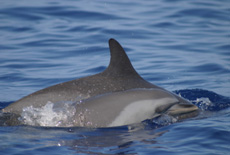Pantropical Spotted Dolphin (Stenella attenuata)
Status | Taxonomy | Species Description | Habitat | Distribution |
Population Trends | Threats | Conservation Efforts | Regulatory Overview |
Key Documents | More Info
Status
MMPA Depleted - Pacific northeastern offshore stock
Taxonomy
Kingdom: Animalia
Phylum: Chordata
Class: Mammalia
Order: Cetacea
Family: Delphinidae
Genus: Stenella
Species: attenuata
Coastal spotted dolphins (Stenella attenuata graffmani) ![]() are a subspecies of the pantropical spotted dolphin and are managed as a separate stock.
are a subspecies of the pantropical spotted dolphin and are managed as a separate stock.
Atlantic spotted dolphins (Stenella frontalis) are another species of spotted dolphin.
Species Description
Like other dolphins of the genus Stenella, these are relatively small dolphins, reaching lengths of 6 to 7 feet (2 m) and weighing approximately 250 pounds (114 kg) at adulthood. They have long, slender snouts or beaks. Like the Atlantic spotted dolphin (Stenella frontalis), pantropical spotted dolphins are without spots when born, accumulating them as they age until they are almost completely covered with overlapping patterns. Pan-tropical spotted dolphins are also distinguished by a dark "cape" or coloration on their backs stretching from their head to almost mid-way between the dorsal fin and the tail flukes and by a white-tipped beak.
Mating and calving occurs year-round, with gestation being like that of most dolphins, around eleven months. Lactation often takes place for two years, but also can last for only one year. At three to six months old, however, calves will begin taking solid food. Calving intervals depend on the population, but range from two and a half to four years. Maturity occurs at around 11 years of age and maximum longevity is 46 years.
Pantropical spotted dolphins often occur in groups of several hundred to one thousand animals. They are considered quite gregarious, often schooling with other dolphin species, such as spinner dolphins. Although specific migratory patterns haven't been clearly described, they seem to move inshore in the fall and winter months and offshore in the spring. They feed primarily on mesopelagic cephalopods and fishes.
Habitat
Spotted dolphins spend the majority of their day in shallower water typically between 300 to 1,000 feet (90 to 300 m) deep. At night they dive into deeper waters to search for prey.
 Pantropical Spotted Dolphin Range Map (click for larger view PDF) |
Distribution
Animals of the northeastern stock are found in the eastern tropical Pacific Ocean (ETP) far at sea. Coastal spotted dolphins are found within 100 miles of the coast. A Hawaiian stock occurs throughout the islands but is not considered depleted. The entire species itself can be found in all oceans of tropical and subtropical climate worldwide.
Population Trends
At the time of the MMPA depletion listing, the northeastern offshore spotted dolphin was estimated to be between 19 and 28 percent of its pre-exploitation population size and the coastal stock was estimated to be at 42 percent of its pre-exploitation population size. Currently the northeastern stock is estimated to have a population size of 737,000 and the coastal stock size is 149,400 (Gerrodette et al. 2005). The long term trend is flat for the northeastern stock and a trend is not available for the coastal stock. The current population size of the non-depleted stocks is as follows: Hawaii - 10,260, Atlantic - 4,400, Northern Gulf of Mexico - 91,300. See below for links to the most recent stock assessments for the U.S. populations.
Threats
Due to the as yet unexplained association between large yellowfin tuna and some dolphins in the ETP, these stocks of spotted dolphins have been the targets of the tuna purse-seine fishery that uses the dolphins' locations to find tuna. Many dolphins used to be caught in the nets and suffocated. Currently, fishing methods for tuna imported into the US under the Dolphin-Safe program do not allow such destructive fishing practices. The northeastern spotted dolphin is considered to be the dolphin species most affected by the tuna purse-seine fishery in the ETP. Interactions with tourists are a growing issue for the Hawaiian stock.
 Pantropical Spotted Dolphin (Stenella attenuata) Photo: © Alison Cohan, Pacific Whale Foundation. |
Conservation Efforts
Pantropical spotted dolphins are considered Lower Risk - Conservation Dependent in the IUCN Redlist. ![]()
The International Dolphin Conservation Program Act (IDCPA) [pdf] directed NOAA's National Marine Fisheries Service (NMFS) to determine if the chase and encirclement of dolphins in the purse-seine fishery for tuna in the ETP is having a significant adverse impact on depleted dolphin stocks. As part of this determination, Congress specified that population surveys be undertaken in 1998, 1999, and 2000 to generate new estimates of dolphin abundance under the IDCPA.
Other ongoing research considers how the fishing effort affects the mother-calf bond, life-history information, and stock structure. Two programs run by NMFS' Southwest Fisheries Science Center aim to conserve spotted dolphins: The Dolphin-Safe Program focuses on reducing fishing-related dolphin mortality by developing alternative fishing methods that do not involve dolphins. The Dolphin Energetics Program focuses on determining whether energetics limitations associated with the fishing practice may be contributing to the observed lack of recovery of fishery-associated dolphin stocks in the ETP.
Regulatory Overview
In 1980, NMFS listed the coastal stock as depleted under the Marine Mammal Protection Act. The offshore stock was listed as depleted in 1993. See the Key Documents section below for more details.
Key Documents
(All documents are in PDF format.)
| Title | Federal Register | Date |
|---|---|---|
| Depleted Designation for Northeastern Offshore Stock | 50 CFR 216.15 | 1993 |
| Stock Assessment Reports | n/a | various |
- Listen to Spotted Dolphin Sounds
- NMFS Southwest Fisheries Science Center Spotted Dolphin Information
- International Dolphin Conservation Program Act
- NMFS Southwest Region Tuna and Marine Mammals site
References
- Gerrodette, T. et al. 2005. Preliminary estimates of 2003 dolphin abundance in the Eastern Tropical Pacific [pdf] [1.1 MB]. NMFS Southwest Fisheries Science Center Administrative Report LJ-05-05.


